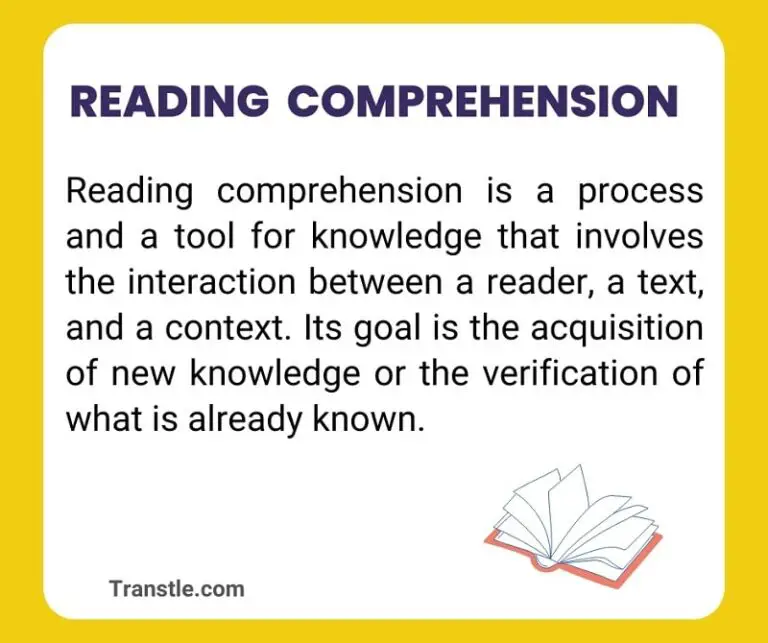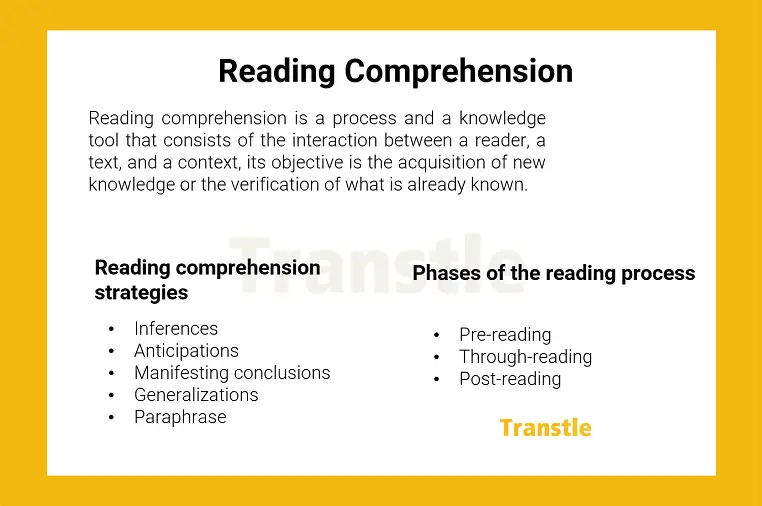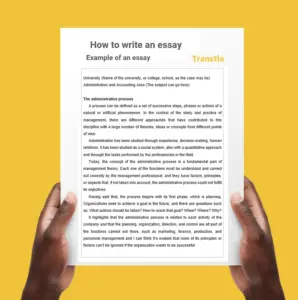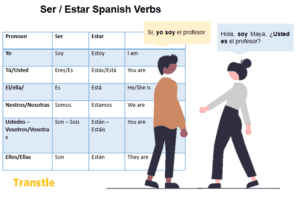Reading comprehension: Concept, Phases, Levels, & Strategies

What is reading comprehension?
Reading comprehension is a process and a tool for knowledge that involves the interaction between a reader, a text, and a context. Its goal is the acquisition of new knowledge or the verification of existing knowledge.
Reading comprehension is an interactive, constructive, and productive process where the reader performs the act of reading, but goes far beyond skimming the pages, because when reading, questions about the information arise in the reader’s inner world.
In the process, readers may accept or reject the information presented, while simultaneously striving to understand the author’s intended meaning. This builds new knowledge and fosters personal understanding.
Contents
Characteristics of reading comprehension
Reading comprehension is a selective process. Readers actively choose the necessary or relevant information to construct the meaning of the text, filtering out secondary details. The reader’s prior experience plays a crucial role in this process, aiding in the interpretation and construction of meaning.
During comprehensive reading, the reader forms a mental representation of the text. This involves condensing and organizing the information, discarding irrelevant details, and retaining only what’s essential for understanding. Ultimately, the reader is able to draw generalizations about the content and achieve a solid grasp of the material.
The nature of Text
Text is a collection of signs with communicative intent. It can also be defined as any object, material, or thing that carries meaning. Printed text is one of the most common forms of text, and this section will focus on its characteristics.
See also: Text: Definition, Structures, Types & Examples
Printed text
Printed text is defined as a set of encoded signs from a writing system. In other words, it comprises letters or graphic representations of a language that convey a message or meaning. Text is a fundamental component of study and one of the key elements of reading comprehension, alongside the reader and the context.
Text structures
Texts, particularly academic texts, are organized using different structures known as text structures. These structures include:
Formal structure
The formal structure of a text refers to its internal organization, that is, how ideas are arranged. The typical order is:
Introduction: The introduction serves as the beginning of the text, where the topic is presented and the reader is introduced to the context.
Body: The body is the main part of the text, where the content is developed and the supporting arguments are presented.
Conclusion: The conclusion serves as the closing of the text, where the main points are summarized and a final message or call to action is provided.
This structure serves as a guide for the reader, leading them through the text and facilitating their understanding of the topic. It ensures a logical progression of ideas and provides a clear framework for presenting information.
Semantic structure
The semantic structure of a text implies coherence and cohesion. It encompasses two key aspects:
Textual coherence: This refers to the distribution, order, and logical connection between the ideas and different parts of the text. It ensures that the text flows smoothly and that the ideas presented are logically related and easy to follow.
Cohesion: This refers to the syntactic and lexical mechanisms that connect the elements within a text. It involves the appropriate use of grammar, punctuation, and vocabulary to create a unified and cohesive whole.
In essence, the semantic structure ensures that the text is well-organized, logically structured, and easy to understand. It eliminates any inconsistencies or gaps in the information, ensuring that the message is conveyed effectively.
Grammatical or linguistic structure
The grammatical or linguistic structure of texts refers to the intricate arrangement of words to form sentences and convey ideas within a specific language. It encompasses the organization of words, syntax, morphology, and the overall grammar of a language. This structure serves as the foundation for constructing well-written texts, where the appropriate selection and usage of words are paramount.
Phrases or stages of the reading process
The reading process is a process of understanding ideas expressed in a medium that evidently involves the act of reading, which consists of interacting with a text, scanning it, and deciphering the meaning given by the author. The reading process, according to the way the text is approached, occurs in three key moments: pre-reading, through reading and post-reading
1. Pre-reading
Pre-reading is the initial stage of the reading process that involves engaging with a text in a cursory manner to gain a general overview and establish a foundation for deeper understanding. This preparatory phase serves as a crucial step in preparing the reader for a more comprehensive and engaging reading experience.
2. Through-reading
Through-reading or while-reading, the second stage of the reading process, delves into the text’s content with greater depth and scrutiny, engaging both mechanical and internal aspects to fully grasp the author’s message. During this critical phase, the mind actively constructs mental representations, employs deductive reasoning, condenses information, and formulates personal interpretations, ultimately achieving a profound understanding of the text.
3. Post-reading
Post-reading is the final stage of the reading process and is a crucial step in consolidating the knowledge and information gained during comprehensive reading. Through a series of directed activities, readers engage in self-regulated learning strategies to evaluate their comprehension and solidify their understanding of the text.
Levels of reading comprehension
As the name suggests, reading comprehension levels are the stages or degrees of understanding that a reader can achieve during the reading process. These levels are:
- Literal Level: At the initial stage of reading, the reader grasps the information without adding or subtracting anything, simply taking in what is presented. This passive approach marks the beginning of the comprehension process.
- Reorganization: In this level, the reader actively restructures the text to enhance their understanding. They identify, classify, summarize, and analyze the essential ideas that convey the text’s meaning.
- Inferential level: The inferential level involves linking the explicit information in the text with prior knowledge and experiences to draw conclusions or form ideas that are not explicitly stated. It is a process that takes place within the reader’s mind.
- Critical level: With the critical level, readers evaluate the text, accepting or rejecting what they read and comparing their criteria with those of the author. This level presupposes the successful completion of the previous levels.
- Literary and Artistic Appreciation: This highest level of comprehension is reached when the reader can recognize and appreciate the aesthetic, intellectual, and even recreational qualities of the text or work. This appreciation enriches the reader’s experience as a thinking being.
Basic internal structures of texts
Texts exhibit various internal structures that organize and convey their content effectively. These fundamental structures include:
1. Factual structure: This structure presents facts, data, or information without the need to demonstrate or prove anything. As the name suggests, it focuses on presenting straightforward information, as seen in narratives or news articles.
2. Problem-Solution Structure: The author introduces a problem and then proceeds to solve it. They support their ideas with arguments to convince the reader, often employed in scientific articles.
3. Thesis-Proof Structure: This structure shares similarities with the problem-solution structure, but instead of presenting a problem, it introduces a thesis statement, typically related to a scientific, social, or philosophical topic. The author then develops their argument and defends their position using evidence and reasoning.
Reading comprehension strategies
To effectively grasp the meaning of a text, readers employ various strategies that guide their comprehension process. These strategies enable them to delve deeper into the text’s content, reaching higher levels of understanding. Here are some key strategies for reading comprehension:
- Inferences: Inferencing involves drawing conclusions based on premises, which are statements or propositions. Readers form ideas that are not explicitly stated in the text but are generated within their minds by combining the text’s content with their prior knowledge and experiences.
- Anticipations: Anticipation occurs when readers predict the upcoming content of the text based on what they have already read. They form hypotheses about what might follow, actively engaging with the text.
- Conclusions: Once they have finished reading, readers draw conclusions about the overall meaning and implications of the text. They summarize the main ideas and synthesize the information they have gathered.
- Generalizations: Generalizations involve formulating overarching statements or principles based on the information presented in the text. Readers move beyond specific details to identify broader concepts and patterns.
- Paraphrasing: Paraphrasing involves restating the text’s content in their own words. Readers demonstrate their understanding by expressing the ideas in a new way, ensuring they have obtained the meaning effectively.

Read next



